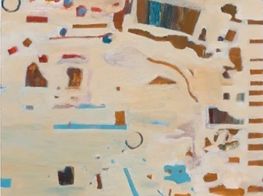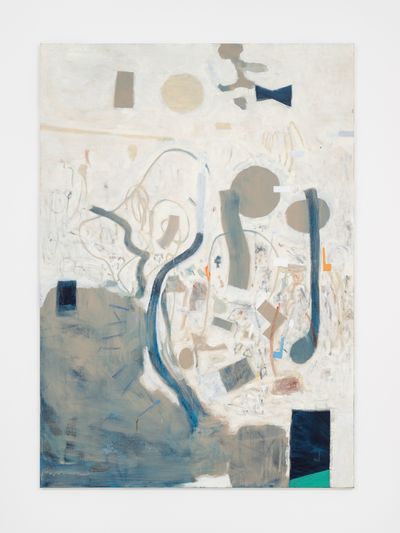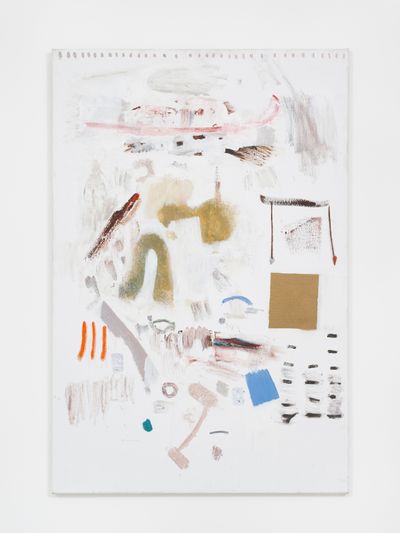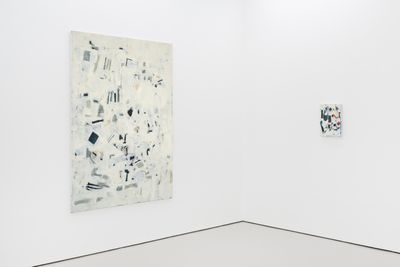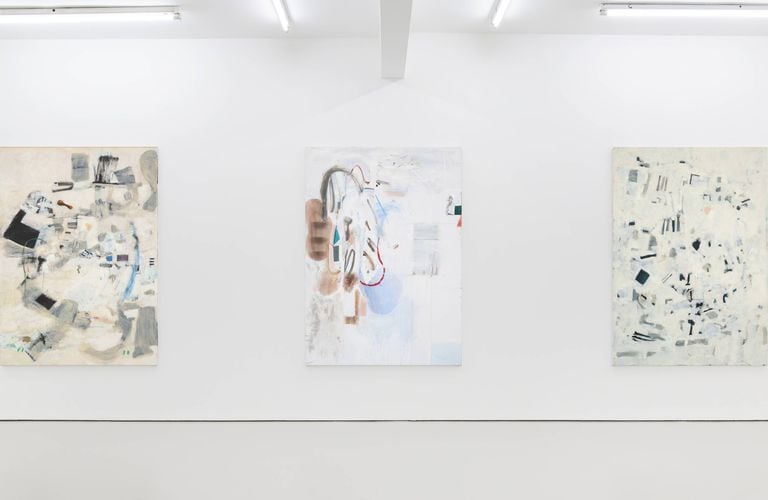
Vanessa Carlos Introduces Painter Libasse Ka in London
Art fairs are strange places. Armies of sales staff swarm around the palatial booths of mega galleries. But beneath this surface buzz there still remain opportunities for discovery in quieter spaces on the fringes of the chaos.
I was reminded of this at the most recent edition of Frieze London, during a moment of respite, when Vanessa Carlos—co-founder of East London gallery, Carlos/Ishikawa—introduced me to the work of Libasse Ka, a young Senegalese abstract painter based in Brussels.
Carlos proceeded to regale me with the story of a chance encounter between Oscar Murillo and Ka in a Brussels shop, which eventually led the young artist to her. On closer inspection the painting revealed two sets of initials 'O.M' and 'V.C' connected by a curved line; a small homage from Ka to his mentors. It was a surprisingly touching gesture that felt at odds with much of the commotion on show elsewhere.
Ka spoke to me from his home in Brussels over Zoom on the eve of his first major solo exhibition hosted at Carlos/Ishikawa (20 January–17 February 2024). As Ka discussed his journey from Senegal to Brussels and his path to becoming an artist, I felt relieved that he was now under the guidance of a gallerist so well suited to nurturing young artists through their early years.
To begin, could you tell me a bit about Senegal? What was it like growing up there?
I was born in Cambérène, Dakar, and grew up in Kolda, and then Matam, a town on the Mauritania-Senegal border, with my mum and brother. At ten years old, I came to Belgium. However, it was Senegal that was most important to my development. I try to go back every so often, but sometimes feel a bit alienated from my past there.
How did you get into painting?
I've always been interested in making figures. When I was really young, I made toys. As a child, I watched movies such as Batman or Spiderman and imagined myself as those superheroes when I walked around the streets. I did this a lot when I was younger—invent stories in my head.
What did you make your figures out of? How old were you then?
I scrunched up wrappers from sweet packets and made very small figures.
I must have started at about ten years old. It has been a reflex of mine since I was young. If I saw an action figure or dragon in a movie, I would want to make it. I think my relationship with painting came a bit later. I used to draw comics and manga in my bedroom, and this has played into what my practice is today.
When did you start to move towards abstract painting?
I feel that when you're younger and see something that you're impressed by, you copy it. You then begin to ask yourself, 'What can I learn from this and how can I develop my own style?'
When I moved to Brussels, I was aware of all the big-name Belgian artists such as Luc Tuymans. I used to love to draw a face as beautifully as possible, and very technically.
It wasn't until a gallerist in Brussels showed me the work of painters like Belgian artist Walter Swennen that I became aware of another kind of painting. I have felt ever since that it is important for my work to exist in dialogue with the deeper history of painting. For example, Raoul de Keyser was a big fan of Blinky Palermo.
A wise man once told me: 'Painting is just activating the eye.' I found a big freedom from this as it taught me that painting wasn't all about finding a message, but rather something you can just experiment and have fun with. This was especially important when I was younger and more insecure about what I could and couldn't paint.
Vanessa Carlos told me a story about how Oscar Murillo and you met by chance and developed this friendship.
Yes, we met while I was working in a shop in Brussels. He walked in one day. We got chatting and he asked me to come and hang out with him in his studio. We became friends and that led me to Vanessa.
Has he acted as a mentor to you?
Both Oscar and Jan Van Imschoot, while a little older than me, give me a lot of general life advice. I really look to them for the way they develop their ideas. I feel very lucky to have people like them that I can turn to, and talk through my work.
Tell me about your process. Do you make preparatory drawings? Or do you use other images or source material?
I work on an idea, something that develops in my head. It can often be a problem that I am trying to solve, whether connected to the subject or something more technical. The big conversation for me is around painting rather than a political message.
For this show at Carlos/Ishikawa, I have taken another step to bring more conversations into the work. For example, some areas of the canvas are raw, with no paint.
Most of the time I repeat things a lot, so it comes directly from my hands. It feels intuitive, although I have an order in my mind. But I don't want to be too ordered, so I push myself to open up as well.
Are you good at knowing when to stop painting or do you find that challenging?
It depends on the painting. On the whole I'm good at it, but sometimes it's a real struggle. I usually need a week to make a decision.
Do specific experiences from your life, or objects, trigger ideas for a painting?
Often when I walk outside I suddenly see an object. It can be something minuscule that triggers an idea, like a broken line on a wall that makes me question how I am using the drawn line in my compositions.
Main image: © Libasse Ka. Courtesy the artist and Carlos/Ishikawa, London. Photo: Damian Griffiths.

